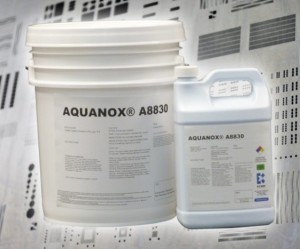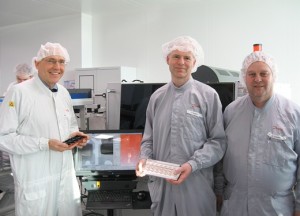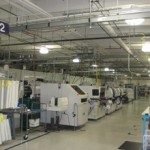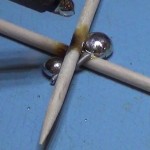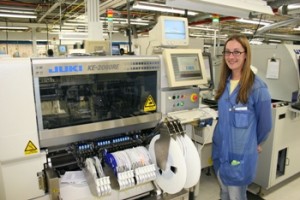Mark Stansfield, SolderStar
 The future holds the possibility to monitor all machine data through technology developed by forward-thinking companies like SolderStar. Manufacturers will be able to profit from these resulting in increased productivity and profitability.
The future holds the possibility to monitor all machine data through technology developed by forward-thinking companies like SolderStar. Manufacturers will be able to profit from these resulting in increased productivity and profitability.
Traditionally the main user of real-time reflow oven performance monitoring systems were medical, safety critical and military applications. The drive for smarter and leaner systems that collaborate has driven specialist manufacturer of thermal profiling equipment to take its Machine Monitoring Platforms to the next level to meet the needs of this exciting new development.
One example of this evolvement is the real-time monitoring solution SolderStar SMARTLine, which is is essentially a suite of hardware and software products allowing electronic manufactures to gain a real insight into how the thermal process is performing.
It can be scaled across multiple manufacturing lines or factories and provides the networking, data collection and collaboration modules to allow ovens to be as smart as any other pieces of equipment on the line. Using well-established networking protocols and infrastructures just makes sense, existing skills in IT and network configuration make deployment much more simple and end users are comfortable with management long term.
Using data exchange format such as XML also makes things much simpler from both a development and integration point of view. Any format can be ultimately used, but the web based techniques championed for IoT are well established and work well. There is XML processing libraries in all major development languages, many are free and make the reading and writing of these formats trivial for a software engineer.
What can we do today and how developments are underway?
Companies are pushing forward with development to work towards the smart factory concept, and SolderStar is no exception to this rule, with existing measurement technology already developed to make the transition relatively quick, with focus on the development of connectivity solutions that allows measurement units to be networked, gather and share their data to any system that is interested.
With interest from customers and enquiries already being voiced, SolderStar were tasked with answering the ‘call’ to bring Industry 4.0 to profiling ovens with particular interest from a multi-national electronics brand.
SolderStar could already provide data for every assembly that passes through the line, including zone temperatures, speed, barcode, time/date, and profile data and soldering process parameters.
In addition to this we can provide live information which shows what is happening at the line now, the system is also ‘two way’, not only can measurement data be streamed from the oven, but it can also make requests to the Smartline system to perform an action on the line, for example driving a light tower or forcing a SMEMA signal to stop the feed of product into the oven.
The system came together very quickly, as in essence 50% of the required system was already well established. A system was already in place that produced ‘big data’ from an oven, and its output easily imported to factory management software-job done – or so we thought!
SolderStar quickly realised that the move to full factory management integration was not something realistic for many, especially if the current phase of involvement is “let’s measure and see what is useful to us.”
There was also the need to show the power this data can bring, so SolderStar developed a focussed software tool named ‘SMARTLine – Central’.
SMARTLine – Central is a web based software system that receives data from the networked nodes fitted to the ovens; it is intelligent and needs little or no configuration for a new site. All items are intelligently created as data begins to flow into the system; data is stored using SQL and NOSQL techniques to provide a robust and scalable data gathering solution. It can be run on anything from a Raspberry Pi to a virtualised server, depending on how much data is flying around.
The initial motivation ultimately was to show potential customers that they can improve their process quality right now and the investment in improved oven monitoring is a keystone in their move to increasing production data intelligence and smarter methods.
With the tools we have today, manufacturers can immediately see through ‘dashboards’ and web based reporting how the thermal process is performing whether that be live and historically.
Adding to this development is underway on reports that provide information from the data about line to line performance, so that differences can be highlighted and questioned.
So where do we go from here?
It is my belief that groups of intelligent sensors collaborating to produce the specialised needs of the individual elements of the process are best suited. Multiple decisions need to be taken in real time and require embedded intelligence with local decision making capabilities at the production line, rather than a central system making all decisions from lower intelligence units. Using the correct technologies means that powerful systems can be quickly created and the ‘big data’ they generate is made available to whatever can make use of it.
One example is the desire to reduce energy and nitrogen consumption, with its obvious cost saving. By analysing oven throughput information over time, plus integration of data from other systems such as oxygen sensors and real-time power consumption measurement, it will allow all the data to be correlated to best achieve any savings.
Future development in oven technology will allow machines to be controlled more intelligently and remotely resulting in the lowest cost model for manufacturing flow.
Alternatively, if end users already have this capability then integration portals will allow the raw process data to be received and analysed by third party system that make use of the data to make their own informed decision.
The future holds the possibility to monitor all machine data through technology developed by forward-thinking companies like SolderStar. Manufacturers will be able to profit from these resulting in increased productivity and profitability.
wFor further information visit www.solderstar.co.uk
Skyscraper 1










